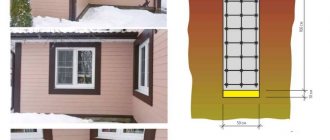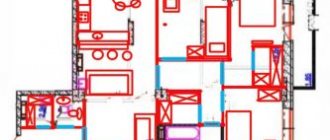It is quite understandable that the apartment owner wants to make it more comfortable, especially considering the projects of some apartment buildings. At the same time, the owner often does not care about issues of construction or legal standards and all the “comfort” has to be rebuilt to its original position. Relocation of a bathroom is planned quite often and in some cases, for example, when the layout of an apartment is completely changed, it is simply necessary.
Currently, it is becoming increasingly popular among owners to enlarge and move the bathroom into the hallway, bathroom, kitchen, pantry, or even into the living room. It is worth noting that it is much easier for owners of apartments located on the ground floor or non-residential premises to agree on the transfer of a bathroom.
The owner who has set himself such a task will face two sides of the issue : legal and technical .
Two options for connecting a bathroom in an apartment when moving it
From a technical point of view, carrying out such a redevelopment is not so difficult. First of all, when moving a bathroom, it is necessary to install communications under the location of the future toilet, in simple words - a drain riser and cold water for draining. The drain riser is constructed from a plastic pipe with a diameter of 100 mm. which is launched at a slope of 00.2 - 00.3. Cold water can be supplied using any available materials, be it metal, polypropylene or metal-plastic.
Of course, no one wants to enjoy the spectacle of open pipes in their apartment, and therefore the desire to somehow hide them in the wall is understandable. In this case, you can arrange a plumbing box, but a mandatory item will be the installation of an inspection hatch on it, with the help of which access to the same pipes will be provided.
This scheme only works if the bathroom is planned to be moved at a distance of no more than 5 meters. Otherwise, it will not make sense to implement such a project due to the fact that the natural slope of the drain pipe will raise the toilet to a height that is unacceptable for the layout of an average apartment, and a half-meter podium will turn your toilet into a throne room.
But in this situation there is a solution: a forced sewer system. Without going into details, it is a pump with a chopper.
The forced sewerage system has two significant advantages: drainage occurs through pipes of smaller diameter (20 and 32 mm) and can be carried out not only horizontally but also vertically up to seven meters high. Currently, there are many models of forced sewer systems with different designs and from different manufacturers.
However, the technical side is not the only thing that should worry you. In addition, there are a number of sanitary and construction rules that must be followed when moving a bathroom to the territory of a former kitchen or corridor in an apartment.
Relocating a bathroom: construction and sanitary requirements
- The first and main requirement is to place the bathroom above the non-residential area and non-residential rooms (storage room, corridor, utility room, etc.).
- It is prohibited to place bathrooms above kitchens.
- It is possible, however, to move the bathroom to the room above the kitchen in two-level apartments or in apartments on the ground floor.
- The entrance to a room equipped with a toilet should be located exclusively in the corridor. Redevelopment with an entrance to the restroom from the living room or kitchen is prohibited. The exception is the exit from the bedroom to the combined bathroom, but in this case there must be another bathroom in the room with a separate entrance from the corridor.
- It is prohibited to attach engineering equipment and communications to the walls adjacent to the living rooms of neighboring apartments.
- The floor level in the bathroom should be 15-20 mm. lower than in the rest of the apartment, or should be separated by a threshold.
- The floor in the newly created restroom should be covered with waterproofing material.
- If the floors in the house are wooden or of a mixed type, then you will have to abandon thick cement screeds. All work in such houses must be carried out with calculation of loads on the floors.
Let's consider moving a bathroom from the point of view of coordinating redevelopments:
As for the procedure for approving redevelopment with the transfer of a bathroom in an apartment building, it is not much different from other redevelopments. You can learn more about the procedure by following this link. In short, you will need:
- registration certificate of the apartment (you can get it at the BTI or at the MFC)
- application of the established form
- redevelopment project
- technical conclusion on the possibility of redevelopment. (in the future, designer's supervision will be required to sign acts on the performance of hidden work)
- an act of complete redevelopment and a new registration certificate of the apartment with the changes made.
It is necessary to add that in some cases an atypical set of documents is required, such as: permission from Mosgaz, Moskomarkhitektura, consent of the bank, etc.
Apartment redevelopment
A kitchen combined with a living room is a very rare occurrence, but undoubtedly original.
The process of ordinary furniture rearrangement is quite simple, but the second option has some difficulties and before deciding on it, you need to clearly imagine the upcoming scope of work, the level of costs, as well as the legal consequences.
Moving the kitchen to another room is part of the redevelopment of the apartment.
The kitchen can be moved to the hallway, living room or other room (depending on the features of the house plan). In most cases, kitchens with an area of less than 10 square meters are moved. m. The transfer process is quite complicated both in terms of coordination and implementation, because it is necessary to transfer and connect utilities to existing pipelines, and also take care of ventilation.
Electrical sockets for stoves and other kitchen appliances are in every room, but the sewage system, water supply and ventilation will require a lot of effort and investment.
For example, to ensure gravity flow of sewage, pipes must be laid at a slope. The required slope angle will be quite difficult to achieve when moving the kitchen to distant rooms. In addition, it can be difficult to route sewer pipes without getting into doorways. If, for similar reasons, it is not possible to provide the proper slope, a sewage pump is used. Its use makes it possible to install a sewerage system without a slope. The only drawback is its cost.
How to move the kitchen into the living room?
Moving a kitchen into a living room is a difficult process, but possible. Such redevelopment can make living more comfortable by combining rooms and allocating an additional room.
Moving the kitchen into the room is popular not only in houses built last century, but even among homeowners in modern new buildings.
Relocating a kitchen using examples of different projects and layouts, as well as important nuances, can be seen in the video:
Let's consider when such redevelopment can and cannot be carried out.
Non-standard kitchen relocation
Moving the kitchen into the living room has both disadvantages and advantages, but there are obviously more of the latter - space and convenience
Moving the kitchen into the living room, bedroom, hallway or other space is a non-traditional approach.
Non-standard relocation is most acceptable when it is not possible to increase the kitchen area in other ways (use a balcony, if available, or move a wall). This option is quite painstaking both in documentary and technical terms. In addition to obtaining multiple permits, the difficulty lies in relocating utility systems.
A non-standard kitchen relocation is a legal procedure, but not without design difficulties.
In addition, it involves complying with numerous requirements and obtaining the necessary papers.
Conclusion
But if the difficulties of re-equipment do not frighten you, and you are ready to pay due attention to cleaning, then you can begin moving the kitchen. In any case, you already know how to move the kitchen into the living room correctly!
far from perfect. The cramped space of 5-6 meters of old housing stock does not allow us to turn around at all. Sufficient in area, but geometrically elongated 10-11-meter buildings of new buildings limit functionality. Technologies allow you to move the kitchen into the living room. But how to legitimize the plan, and is such a step possible in principle?
We understand the current regulations and restrictions.
What kind of kitchen should an apartment have? Photo No. 1
What is a kitchen in a modern apartment? First you need to understand whether this is a residential or utility room, because the requirements for the parameters and operation of both are different.
- In two-level apartments.
- For residents of the top floors, without affecting the contact areas of bathrooms and other auxiliary premises of residents of the lower floor.
- The conditions are feasible in apartments on the first level of the building, located above shops and other non-residential premises.
In the above cases, there is no deterioration in the living conditions of other citizens, but plans still need to be coordinated. For approval, you will have to think carefully about your options.
Possible solutions
There are two ways. The combined kitchen-living room is organized without changing the location of technological and plumbing equipment. Utility area with all technical equipment. nodes are moved to non-residential premises according to the project.
What you need to consider when doing this:
- it is possible to combine two adjacent rooms during the design installation of an electric stove;
- In the case of gasification, it is not permissible to completely remove partitions between rooms. You'll have to get creative by building custom arched doors or sliding panels. But only after agreement with the BTI.
- An almost win-win option is to move the kitchen to the corridors and verandas. However, it is necessary to design new communications and make changes to the technical passport. This is done by specialists from the Technical Inventory Bureau.
If by hook or by crook the kitchen is moved to another place, a spacious room is freed up. The owner is making plans to arrange a bedroom, nursery or living room here.
As you know, it is prohibited to organize living rooms under the technical premises of neighbors from the upper floors.
The regulation can be circumvented by doing everything according to the law. In place of the former kitchen we will equip a study. We receive non-residential premises. Well, putting a sofa for relaxation is not forbidden.
Non-standard transfer conditions
In order not to get into an unfortunate situation and the work was not in vain, you need to think about the compliance of the redevelopment with the law at the first stage. In order to move the kitchen to another room, you need permission from the organization that is responsible for the redevelopment of residential premises. These documents are developed on the basis of current regulatory documents, which contain many clarifications and prohibitions.
The transfer may become impossible for the following reasons:
- If the comfort of living conditions is disturbed. Previously, no attention was paid to this indicator. In the event of any, even significant, violation, the owner simply signed a paper confirming his consent to these deteriorations. Today this is considered unacceptable.
- In case of violation of the technological instructions of engineering networks. The transfer may not be approved if, when redeveloping the apartment, there is a need to affect the electrical network or water supply system. This point was treated more harshly a few years earlier. The main thing now is that the sites for network redevelopment are freely accessible.
- When connecting rooms whose average temperature differs. Transferring it to a room combined with a balcony is not possible, since it implies changing the heating system to lead it to the balcony. And this is prohibited according to technological standards.
These conventions are the main ones from the entire numerous list of restrictions.
It should be remembered that an illegally redesigned apartment cannot be subject to re-registration.
Is it necessary to legalize the changes made?
Current housing legislation establishes that any major changes in the layout of a residential premises must be previously approved by an authorized organization. It should be noted that unauthorized redevelopment in our country is a prohibited action. Moreover, if in the future the owner wants to sell the apartment, he will most likely face quite serious difficulties. The fact is that the technical passport of the premises will contain one information, but in reality everything will be completely different. Typically, this will significantly affect the price of the apartment, reducing the cost of housing.
Moreover, any inspection by an authorized authority will be able to quickly identify illegal changes to the apartment. This, in turn, can become a full-fledged basis for applying appropriate measures of responsibility to the guilty person. The most common penalty imposed is a monetary fine.
In addition to the administrative penalty, the authorized organization will definitely require that previously made illegal changes be eliminated and everything be brought into full compliance with documentary information. This, in turn, will entail significant financial costs for construction and other services. All these costs will be the responsibility of the person at fault. In the event that a citizen does not comply with the requirements within the established period, the authorized body may raise the issue of eviction of the irresponsible owner.
After this, the housing can be put up for official auction to cover all costs associated with bringing the territory into full compliance. So it’s better to think about all such nuances in advance. It will be much easier to prevent problems from occurring than to later correct violations that have already been committed.
Permissions and prohibitions
If you leave the partition, you can get a great bar
In addition to the stated conditions, there are also certain rules, many points of which, according to current legislation, may not allow the transfer. These prohibitions are justified by separate columns of SNiP and SaNPiNov :
- Moving the kitchen into a living room, which is located according to the building plan above the living area of the neighbors below. The kitchen is a high-water hazard area, as is the bathroom, and in the event of an unexpected flood, the neighbors’ apartment may be damaged.
- The kitchen cannot be moved into the bathroom area. Even if its area is quite sufficient, this is a deterioration of the living conditions itself.
Based on the above conditions and limitations, the conclusion suggests itself that an unconventional kitchen relocation is impossible. However, there are official regulations, as well as a number of tricks that allow you to carry out the transfer:
- There are no transfer restrictions for residents of apartments located on the ground floor.
- Owners of multi-level apartments (excluding the first level) are allowed to move the kitchen, since there is no danger to the living quarters of the neighbors below.
- Moving the kitchen is allowed to a place that is not residential in the apartment below. This could be a hallway or a storage room.
It should be noted that this type of redevelopment is permitted to owners of apartments under which there are shops, offices or cafes. Administrative buildings are not residential, so there are no restrictions for owners of such apartments.
Relocation of household appliances and kitchen electrical equipment
Transferring equipment is not an easy task and has a number of nuances
Appliances and electrical equipment are of great importance when relocating a kitchen. Some government bodies that are involved in the development of permitting documents are loyal to this. If the neighbors' living quarters are located below, the transfer may be allowed provided that water-related items are located on the territory of the non-residential premises of the apartments below.
In a kitchen moved to another room, a gas stove cannot be used, since the gas pipeline can only be installed in the kitchen area, and changing the layout of gas pipes is punishable by law. Only the option of using electric stoves is acceptable.
When using an electric stove for constant cooking, the cost of electricity increases. The use of gas stoves in this regard is more economical.
Relocation of plumbing and communications
Relocating kitchen plumbing and utilities is usually the most lengthy and complex process.
Moving the kitchen to another room will not make sense without moving the sink, which entails changing the water supply and sewerage systems:
- Before redevelopment, a new water supply and sewer plan must be approved.
- New wiring of the water supply and sewer system should be carried out from the closest point, which is located in the kitchen or bathroom.
- Water supply and sewer pipes blocking doorways can be laid under the floor screed. In this case, sewer pipes are laid without a slope using a sewer pump, which is mounted under the sink.
- The plumbing system should be planned taking into account the number of all hot and cold water supply points (sink, washing machine or washing machine).
- To carry out the plumbing system, you can use pipes made of plastic, steel, brass or copper.
- The sewerage system uses pipes with a diameter of at least 50 mm.
Expert advice : when moving the sink to some other place, the mixer itself is often changed, the set of which includes two tubes in a metal braid. When using these pipes, do not allow them to be turned over or twisted sharply, in order to avoid the formation of leaks at load points.
Established regulatory standards
If the owner of the apartment nevertheless decides to seriously redevelop his property, he first needs to familiarize himself with all the rules and standards that apply in this area. The main document in this case, of course, will be the Housing Code of the Russian Federation. It contains all the basic information about the specifics of making changes to the current redevelopment of housing, as well as about the responsibility that may be assigned to the guilty person.
If we talk about other regulatory and legal acts that include information on housing redevelopment, we can highlight the following:
- Various Decrees of the Government of the Russian Federation, which may regulate issues of redevelopment. Moreover, these documents establish a list of papers that the owner must collect in order for the authorized organization to issue him official permission for redevelopment.
- Current sanitary standards, which also include various information about the features of redevelopment, as well as established standards.
Other standards, as well as rules, may be contained in additional regulations. For example, the Law “On Gas Equipment” contains information about the features and rules for installing gas stoves.
Room ventilation
Proper ventilation will help maintain the necessary humidity in the kitchen.
There are special conditions for ventilation of the room into which the kitchen is planned to be moved:
- The air ventilation of the new kitchen should pass through the duct of the old room. This entails pulling the ventilation duct through all the rooms in the path.
- Air from the relocated kitchen should not penetrate through the ventilation ducts to the neighbors.
- It is prohibited to connect ventilation ducts to bathroom ducts.
- If the length of the ventilation duct is large enough, it is necessary to additionally install fans that stimulate natural draft.
Advice : if it is necessary to conduct a ventilation duct through living spaces, stretch or multi-level ceilings will help. However, a permit is required to make holes in load-bearing walls.









